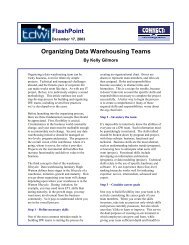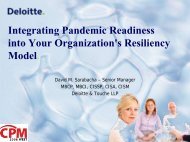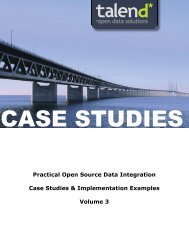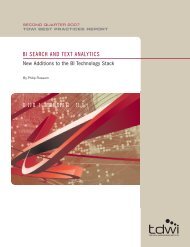Network and Certification Training for Windows ... - 1105 Media
Network and Certification Training for Windows ... - 1105 Media
Network and Certification Training for Windows ... - 1105 Media
Create successful ePaper yourself
Turn your PDF publications into a flip-book with our unique Google optimized e-Paper software.
Wednesday, March 28<br />
W2 SECURING MESSAGES WITH EXCHANGE SERVER 2007<br />
8:30 – 10:00 a.m. Beth Quinlan<br />
One of the most common ways <strong>for</strong> viruses to spread is through<br />
e-mail. In this session, you’ll learn about Exchange Server 2007’s<br />
new features <strong>for</strong> virus protection <strong>and</strong> spam filtering. You’ll also<br />
learn how to configure connection filtering, Sender <strong>and</strong> Recipient<br />
filtering, Sender ID filtering, Sender Reputation filtering <strong>and</strong><br />
Content filtering. You’ll also learn about the various options <strong>for</strong><br />
enabling a secure message flow, focusing on the Edge Transport<br />
server role to provide the highest level of protection.<br />
W8 HOW TO GET STARTED WITH A PUBLIC<br />
KEY INFRASTRUCTURE<br />
10:15 - 11:45 a.m. Joern Wettern<br />
More <strong>and</strong> more technologies, like file encryption <strong>and</strong> e-mail signing,<br />
depend on public key infrastructure (PKI). Implementing a<br />
PKI can be a daunting task, however. In this session, you’ll learn<br />
the basic steps you’ll need to take to enable applications that<br />
depend on public key encryption, which components are<br />
absolutely required <strong>and</strong> which ones are optional. You’ll also get<br />
plenty of guidance <strong>for</strong> getting started <strong>and</strong> how to avoid common<br />
critical mistakes that might require re-design <strong>and</strong> re-deployment.<br />
W14 ATTACKER TRENDS AND TECHNIQUES: AN UPDATE<br />
2:30 – 4:00 p.m. Steve Riley<br />
The bad guys just keep getting better! They're constantly changing<br />
their tactics <strong>and</strong> inventing new techniques to cause you<br />
harm, damage your data, <strong>and</strong> make your resources unavailable.<br />
Why do they do this What motivates someone to — let's call it<br />
what it is — commit computer-related crimes How have they<br />
changed <strong>and</strong> improved What kinds of attacks are popular now<br />
<strong>and</strong> why are they so effective What might we expect to see in<br />
the future Steve Riley will help you underst<strong>and</strong> the latest in<br />
attacker trends <strong>and</strong> techniques, so that you can plan appropriately<br />
<strong>and</strong> implement effective processes <strong>and</strong> technologies to<br />
mitigate their threats.<br />
Thursday, March 29<br />
Th2 PROTECTING YOUR NETWORK: CONFIGURING<br />
SERVER AND DOMAIN ISOLATION<br />
8:30 - 10:00 a.m. Ronald Beekelaar<br />
You can’t depend on firewalls alone to protect your network<br />
from attacks or unintended access from the outside or even<br />
from within your network. In this session, you’ll learn how to use<br />
IPSec to isolate servers <strong>and</strong> domain-based networks, <strong>and</strong> ensure<br />
that only managed clients or domain-joined computers can communicate<br />
with important servers.<br />
Th8 USING ISA SERVER 2006 FOR VPN CONNECTIVITY<br />
10:15 – 11:45 a.m. Beth Quinlan<br />
VPN functionality is fully integrated into the firewall architecture<br />
of ISA Server 2006, which enables fast <strong>and</strong> secure remote<br />
access to corporate network resources. In this presentation you<br />
will learn how to:<br />
• Configure ISA Server to accept incoming VPN connections<br />
• Configure a client computer to establish a VPN connection<br />
• Allow internal network access <strong>for</strong> VPN clients<br />
• Configure VPN quarantine on ISA Server<br />
• Create <strong>and</strong> distribute a Connection Manager profile<br />
• Use VPN quarantine on the client computer<br />
• Use the Branch Office Configuration Wizard to configure<br />
your VPN between remote locations<br />
Th14 HOW TO IMPLEMENT A PATCH<br />
MANAGEMENT STRATEGY<br />
2:15 - 3:45 p.m. Joern Wettern<br />
Nobody likes having to deploy operating system <strong>and</strong> client<br />
patches. However, it’s a task you can’t neglect. Fortunately, tools<br />
from Microsoft <strong>and</strong> third parties can make the job easier. In this<br />
session, you’ll learn how to ensure that patches are deployed in a<br />
timely manner <strong>and</strong> with the least amount of work required, while<br />
avoiding mistakes that could interrupt network operations.<br />
Th20 NETWORKING WITHOUT WIRES OR WORRIES:<br />
WIRELESS LAN SECURITY<br />
4:00 – 5:30 p.m. Steve Riley<br />
You’ve heard the tired bleating so often you now think it’s true:<br />
wireless networks can’t be secured, I’ll never let that stuff be<br />
deployed at my company, etc. Well, wireless networks are, in<br />
fact, insecure if you rely only on Wired Equivalent Privacy. WEP<br />
is not equivalent to wired networks, because the physical layer is<br />
air, <strong>and</strong> there is no such thing as “private air.” WEP has now<br />
reached the end of its useful life; proper wireless security is now<br />
built around Wi-Fi Protected Access (WPA) <strong>and</strong> WPA2. Both<br />
protocols operate in modes suitable <strong>for</strong> homes <strong>and</strong> small offices<br />
as well as large enterprises. Learn the risks posed by wireless<br />
networks, how to mitigate those risks with nothing more than<br />
the technology already built into <strong>Windows</strong>, <strong>and</strong> some of the new<br />
management choices <strong>for</strong> wireless networks in <strong>Windows</strong> Vista.<br />
Friday, March 30<br />
F2 USING FOREFRONT CLIENT SECURITY<br />
8:30 – 10:00 a.m. Ronald Beekelaar<br />
Microsoft has released Forefront Client Security — a new security<br />
product that will help you protect your desktops, laptops, <strong>and</strong><br />
servers from emerging threats such as spyware, rootkits, viruses<br />
<strong>and</strong> other attacks. In this session, you’ll learn how to deploy a<br />
client side Forefront policy, get signature updates, view alerts<br />
<strong>and</strong> run reports.<br />
F8 PROTECTING PRIVACY ON THE MICROSOFT PLATFORM:<br />
“PAPER” SECURITY VS. REAL SECURITY<br />
10:15 – 11:45 a.m. Steve Riley<br />
In the era of proliferating privacy regulations worldwide, encryption<br />
requirements are everywhere. However, “encryption” doesn’t<br />
necessarily mean protection. In this session you’ll learn various<br />
encryption approaches that organizations have proposed or<br />
deployed, <strong>and</strong> distinguish between those that merely satisfy a<br />
simple “checkmark” on a privacy auditor’s list, <strong>and</strong> those that<br />
actually provide the protection that was intended by the regulations.<br />
We’ll also explore encryption options in <strong>Windows</strong> <strong>and</strong><br />
delve into how <strong>Windows</strong> protects important secrets.<br />
March 26 – 30, 2007 | TechMentorEvents.com<br />
13
















![Ink Jet Formulation- The Art of Color Chemistry 2005 [Read-Only]](https://img.yumpu.com/42062450/1/190x143/ink-jet-formulation-the-art-of-color-chemistry-2005-read-only.jpg?quality=85)
